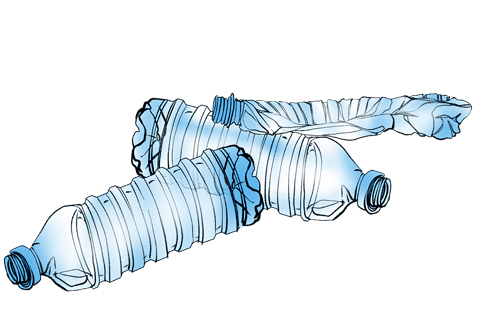To help fight our ‘plastic problem’, geoscientists are needed to assess the full environmental impacts of plastics, compared to alternative materials, at every stage of their life cycle and beyond
Whitchurch, A., Fossil plastics.
Geoscientist 29 (9), 5, 2019
https://doi.org/10.1144/geosci2019-048;
Download the pdf here

Our planet is overwhelmed by plastic. This human-made material has infused our air and snowfall, invaded our rivers and coastlines, penetrated the depths of our oceans, and infiltrated our ecosystems and bodies. Our ‘plastic problem’ has captured public interest, yet in terms of scientific understanding, we’ve only really scratched the surface. We need a better grasp of where our plastic waste is, the pathways it travels and its health impacts—points that are driven home in this special issue on plastic pollution.
While most research has focused on marine plastics, a report released earlier this year highlights a somewhat under-appreciated impact of plastic: climate change.
Plastics & Climate: The Hidden Costs of a Plastic Planet reviews the climatic impacts of plastic over its entire life cycle. And the results paint a bleak picture.
Plastic is largely made from fossil fuels, so greenhouse gases are emitted at every step of the life cycle, from fossil fuel extraction and transport, through refining and manufacture, to end-of-life and beyond. Plastic refining is highly emissions intensive, and whether plastic is landfilled, recycled, incinerated, or left unmanaged in the environment, it continues to give off greenhouse gases.
Particularly worrying is the impact on plankton. Phytoplankton contaminated by microplastics may have a reduced ability to fix carbon via photosynthesis, while microplastics may lessen zooplankton survival, reducing their ability to transfer carbon to the deep ocean. That plastics may interfere with the largest natural carbon sink on the planet should ring alarm bells.
The (conservative) emissions estimates given in the
Plastics & Climate report make it clear that if we carry on producing plastic at the current rates, we jeopardise our ability to keep global temperature rise below 1.5°C. But the results are much worse than that. Petrochemical and plastic industries plan colossal expansion, in part fuelled by the availability of cheap natural gas from hydraulic fracturing (particularly in the US). The report estimates that by 2030, plastic production and incineration will add greenhouse gas emissions equivalent to 295 new 500-megawatt coal-fired power plants, and that number rises to 615 new plants by 2050.
We must be careful not to completely demonise plastic. This revolutionary material has brought many societal benefits. Engineered plastics allow for lighter vehicles with improved fuel efficiency and lower carbon emissions, they reduce food waste and spoilage, and have transformed the medical industry—many of our most innovative medical procedures, including pill casings, implants and prosthetics, depend on plastics.
One interesting alternative is bioplastics, such as those formed from plants or algae, because they have a lower carbon-footprint than petroleum-based plastics. CO
2 is sequestered from the atmosphere as the biomass grows and released back into the atmosphere as the plastics break down—there is no net increase in CO
2 emissions. But bioplastics are still problematic. A rise in their use could intensify pressure on arable land, fertiliser and water consumption, and increase monoculture cropping and pesticide use, thus contributing to the loss of habitats and biodiversity. Plus, while often labelled biodegradable, many bioplastics only do so under intensely high temperatures in industrial composting or recycling plants—most bioplastics lost to the environment pose the same threats as traditional plastics.
Bioplastics do have great potential. With the rise of genetic- and bio-engineering (and ethical considerations aside), they could one day be designed to have a vast range of applications and to be completely recyclable.
Our ‘plastic problem’ requires immediate action. Globally, we must ease our plastic dependency, especially single-use, and create alternative materials. Improved waste management and recycling infrastructures, particularly in developing nations, are urgently needed. Ramping up plastic production, as currently planned, in not an option. Rather, plastic producers should take greater responsibility, factoring reuse and recyclability into the design and committing to collect, reuse and recycle their products. Governments could enforce ambitious emissions targets and introduce levies on fossil plastics, to make them less economically attractive than greener alternatives.
Geoscientists have an essential part to play. In addition to mapping and monitoring plastic pathways, geoscientists are needed to assess the full environmental impacts of plastics, compared to alternative products, over their entire life cycle.
To have any hope of solving our plastic problem, we will require an integrated approach.
AMY WHITCHURCH, EDITOR
[email protected]
Further reading:
Image by LillyCantabile from Pixabay